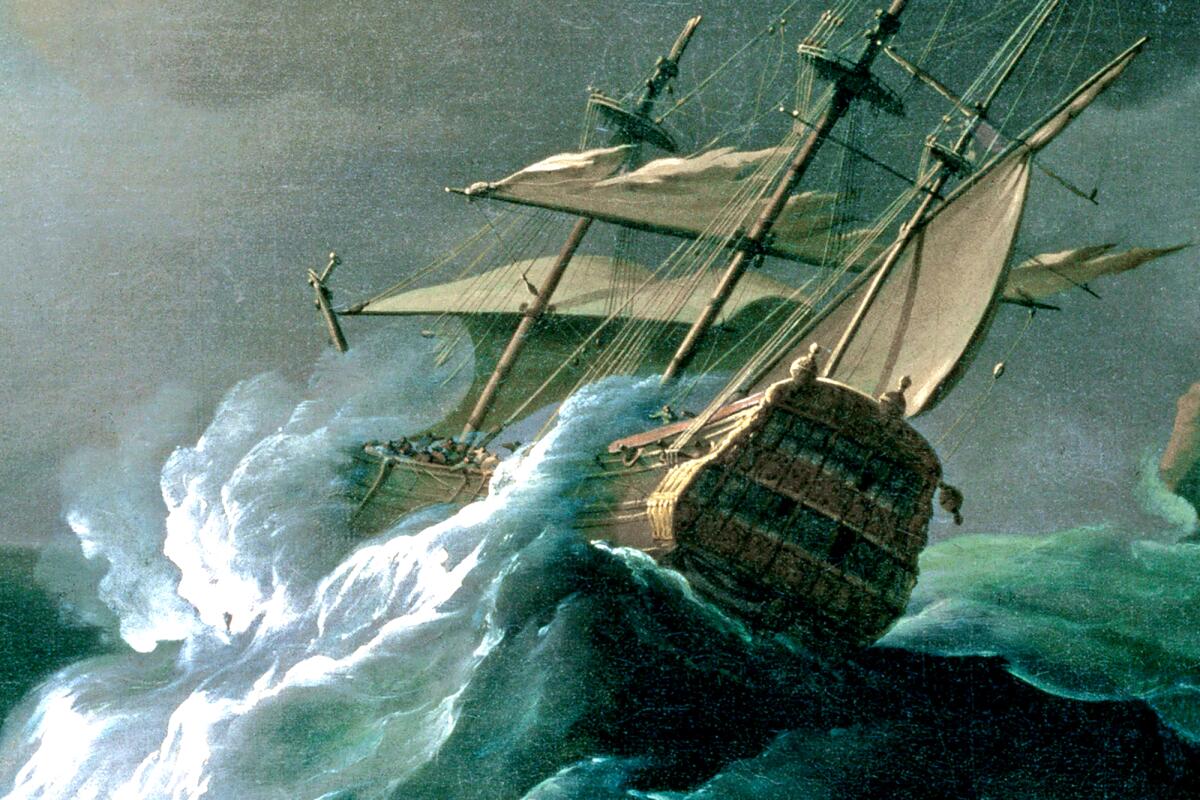As Scorsese preps his ‘Flower Moon,’ David Grann’s new book takes to the high seas

- Share via
Review
The Wager: A Tale of Shipwreck, Mutiny and Murder
By David Grann
Doubleday: 352 pages, $30
If you buy books linked on our site, The Times may earn a commission from Bookshop.org, whose fees support independent bookstores.
What is it about sea stories? Great writers in the tradition of Herman Melville, Joseph Conrad and Patrick O’Brian have used the self-contained world of a ship and its crew to tell stories of fear, greed and rebellion. A shipboard drama, whether it’s a mutiny, a close-quarters battle or a desperate fight to survive the furious elements, shares in common with the locked-room mystery a cast of characters with warring motives and nowhere to go.
New Yorker writer David Grann knows a good story when he sees one; his most recent book, “Killers of the Flower Moon,” about a series of murders on the Osage Indian reservation in the early 1920s, went into multiple printings, and the movie version directed by Martin Scorsese is awaiting theatrical release. In “The Wager: A Tale of Shipwreck, Mutiny and Murder,” he has found not just a good but a great story, fraught with duplicity, terror and occasional heroism.
David Grann is what you might call a writer’s writer.
The story of “The Wager” begins in 1740. Britain was at war with Spain in a brutal struggle to claim uncharted territory. It was colonialism at its most naked and avaricious, and the battles were largely fought at sea. The Wager was one of eight ships in a squadron that launched from Portsmouth, England, and headed to South America, its goal to capture a Spanish galleon loaded with treasure — a prize that would enrich both the crew and the English government.

The Wager was a small ship, tasked with carrying trade goods, small weapons, gunpowder and the squadron’s supply of rum (the analogy of the “powder keg” unavoidably comes to mind). The crew was a combustible mix of regular sailors, marines and impressed crewmen — impressment being a kind of slavery wherein men were kidnapped and forced to serve for an indefinite period.
Five hundred invalids from the Royal Hospital in Chelsea, many in their 60s and 70s, were ordered to fill out the ranks. As old as 80 and as young as 6, the Wager crew “had been thrown together as if they were subjects in a whimsical experiment to test the limits of human sociability,” Grann writes.
That is putting it mildly. The venture seemed doomed from the start. The squadron immediately ran into trouble when typhus and then scurvy, a grotesque disease of vitamin C deficiency, struck down the majority of the crew. After another ship’s commander died, the Wager’s capable captain was transferred to replace him, and David Cheap, an untested officer who had never been in charge of a ship, was named captain of the Wager’s crew.
A fascinating account of retracing the Amazon journey of vanished explorer Percy Fawcett, thought to have inspired the creation of Indiana Jones.
As the squadron approached the tip of South America, the weather worsened; the other ships in the squadron began to turn back. But Cheap, who had just grasped the prize of command over the ship, wouldn’t consider it, and ordered the Wager’s crew to sail into some of the wildest seas and worst weather on Earth.
Many writers have tried to convey just how terrifying the waters around South America’s Cape Horn were in the days of wooden ships and uncertain navigation, as boats battled wild winds, freezing mists and 90-foot waves against a surreal backdrop. One writer was succinct about this Mordor-like terrain: “a proper nursery for desperation.” All this before the Wager passed into Cape Horn, where gales reached 200 miles per hour and subzero temperatures coated the ship with a carapace of ice.

One trick Grann pulls off — again and again — is not showing his hand, and this review honors that accomplishment by not revealing the details of what happens next. Suffice it to say that the Wager and what was left of its crew ran onto the rocks of an exceedingly bleak island off the south coast of Chile.
Given the documentation Grann works with, the reader can intuit that not everyone is going to die (though many do). But as Cheap loses control of his desperate men, starvation, mutiny and murder ensue. British bad behavior scares off a tribe of Indigenous rescuers. And the escape attempts of those who try to make it off the island are so brutal, hair-raising and implausible, the reader is left wondering just what makes some human beings so determined to survive.
Another Grann specialty is on full display — creating a cast of indelible characters from the dustiest of sources: 18th century ship’s logs, surgeons’ textbooks, court-martial proceedings. What a fascinating, conflicted lot they are. Cheap, whose driving desire to prove himself completely extinguishes his common sense. John Bulkeley, the Wager’s gunner, a weapons expert and “instinctive leader” whose Bible-inspired narrative gifts would impel him to write an indelible account of events. “Bulkeley relished recording what he saw,” Grann writes. “It gave him a voice, even if no one but him would ever hear it.”
Then there was Midshipman Jack Byron, 16 when the Wager set sail, whose own account would inspire verse by his renegade grandson Lord Byron on the subject. In his poem “Don Juan,” Byron would memorialize the low moment when starving crewmen killed and ate his grandfather’s dog: What could they do? And hunger’s rage grew wild:/So Juan’s spaniel, spite of his entreating, Was kill’d, and portion’d out for present eating.”
Your ultimate L.A. Bookhelf is here — a guide to the 110 essential L.A. books, plus essays, supporting quotes and a ranked list of the best of the best.
Besides poems, the story of the Wager would eventually inspire books, a flood of press coverage, a court-martial and a continual retelling of the story, from survivors to naval historians to Patrick O’Brian’s early novel “The Unknown Shore.” So why read this book, as opposed to the Wikipedia entry?
Besides Grann’s narrative gifts, there’s the age-old reason — to find out how human beings behave under extremes (without suffering them yourself). And Grann puts his story in context, showing what a raw, naked grab for power the age of colonial expansion was. The Wager’s crew was caught in the cogs of a brutal machine, and many had precious little of what we would call free will.
The other strength of the Wager’s story is that it just gets more and more improbable. How did anyone survive? How did English authorities deal with a massive case of bad publicity? How did the traumatized survivors move on? The story of the Wager is, like many of its antecedents — from Homer’s “Odyssey” to “Mutiny on the Bounty” — a testament to the depths of human depravity and the heights of human endurance, and you can’t ask for better than that from a story. Maybe you get seasick at the thought of a seafaring novel; make an exception in this case. The Wager will keep you in its grip to its head-scratching, improbable end.
Gwinn, a Pulitzer Prize-winning journalist who lives in Seattle, writes about books and authors.
More to Read
Sign up for our Book Club newsletter
Get the latest news, events and more from the Los Angeles Times Book Club, and help us get L.A. reading and talking.
You may occasionally receive promotional content from the Los Angeles Times.









